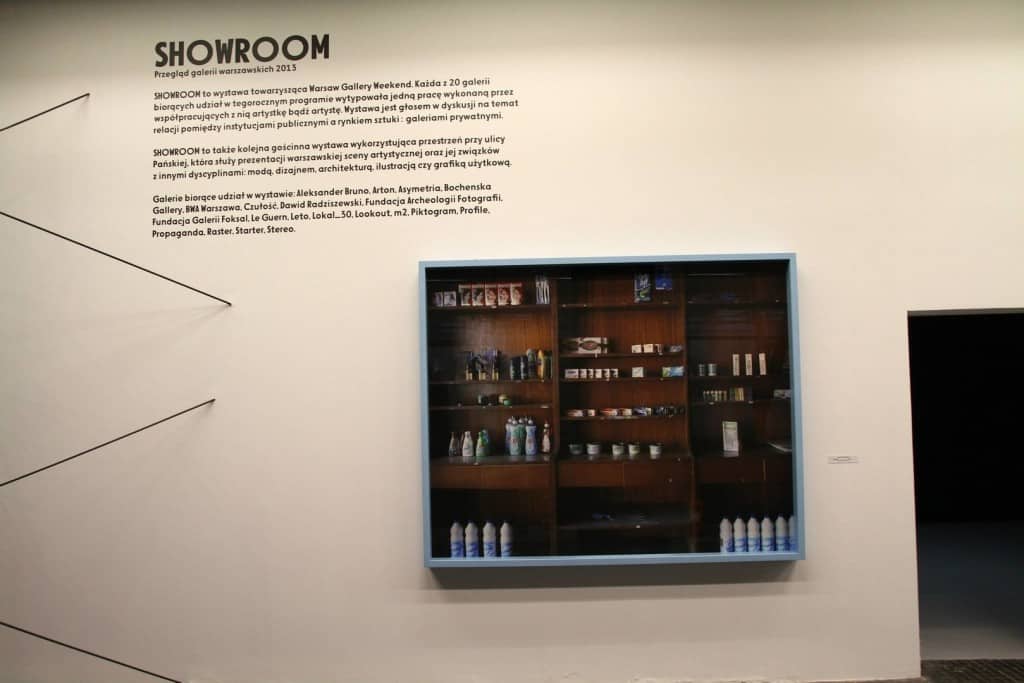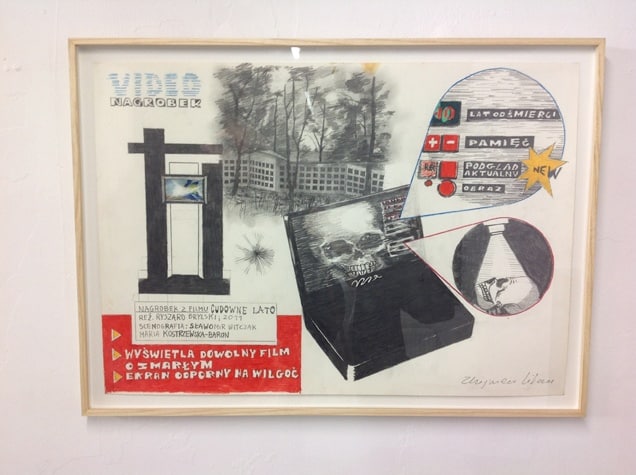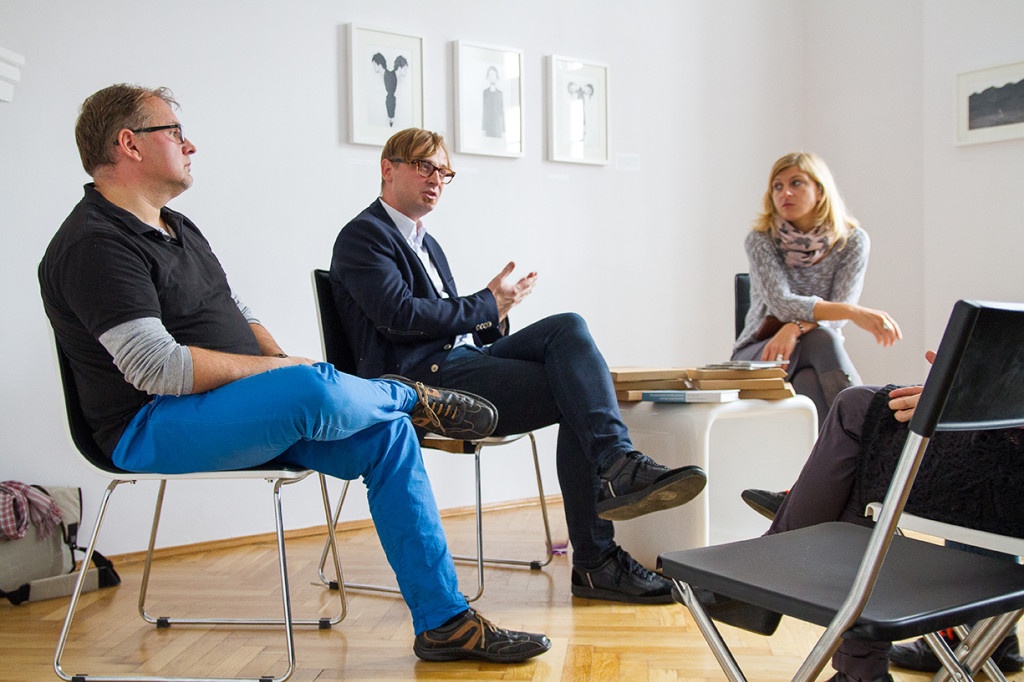This year’s exhibitions on Warsaw Gallery Weekend were very varied. One could enjoy artists from various generations, representing various trends. The differences, both in the profile and the approach of the galleries and artists, were already visible on the joint exhibition of the Museum of Modern Art. This small presentation entitled “Showroom” presented works proposed by 20 galleries, which actively participated in the event, in a small space. It bears mentioning that Pola Magnetyczne gallery was absent. Its owner Patrick Komorowski did not agree to take part in the project. The remaining galleries were to choose one work to present on the exhibition. Therefore, the result was a project „curated” by 20 subjects. The galleries were asked to present their best works in – lets put it this way – not the best of conditions. The works hang one next to the other, very closely apart, in a row, which made it impossible to exhibit them properly. Each work fought for the viewer’s attention, the niceties went unnoticed and, sadly, some of the works lost their attraction. The gallery owners should have predicted that when making their choices. Janek Mioduszewski’s installation, Bodzianowski’s object, Piotr Łakomy’s work and Bownik and Gomulicki’s photos were the most striking works there. They were strong, concrete and attracted the viewer’s eye. Mioduszewski’s wall unit and the work by Łukasz Trzciński which opens the whole gallery presentation, seemed to be alluding, although I’m not sure if it was deliberate, to Museum of Modern Art’s past (as an old furniture store). They summoned the spirit of PRL (Polish People’s Republic) with the shop windows and the interiors typical for most Polish flats. The rest was sadly lost in the excess of chaos.

Jan Mioduszewski, “Showroom”, Museum of Modern Art Warsaw, photo Contemporary Lynx
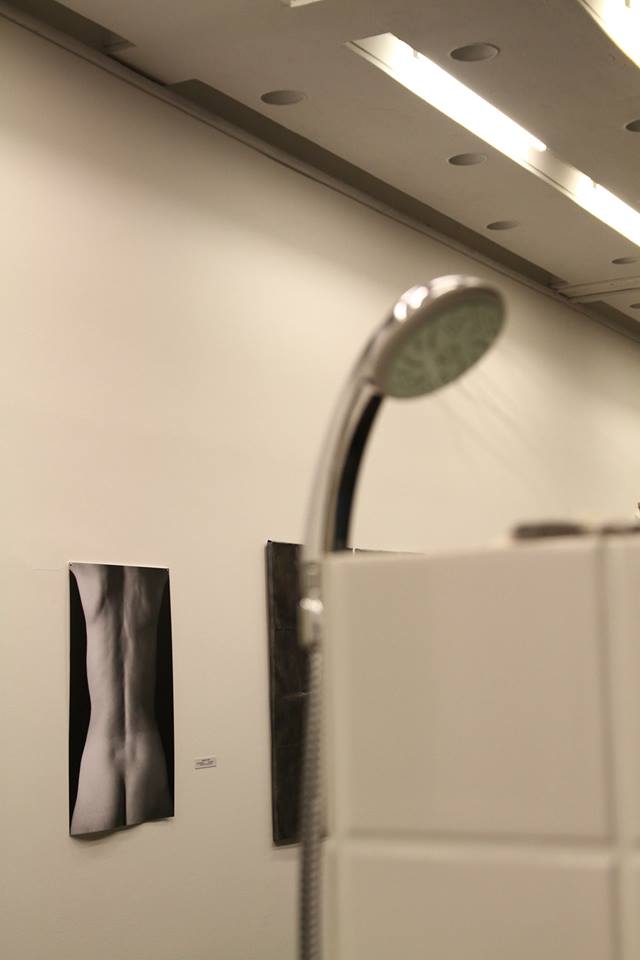
Cezary Bodzianowski, “Showroom”, Museum of Modern Art Warsaw, photo Contemporary Lynx
Most of the exhibitions visited by us were devoted to artists, who use the medium of photography. The exhibition of Fundacja Archeologii Fotografii and lokal_30 were worth visiting. Both institutions presented the classics of Polish art – Zbigniew Dłubak and Natalia LL. The common denominator for both of the exhibitions was the focus they put on the body, its beauty captured in motion, in consecutive gestures and poses. Natalia LL, who was the heroin of one of our articles two weeks ago, presented works from 1960’, which have not been shown before. What arrested attention most, were the large-format works presenting the images of the artist and her then husband Andrzej Lachowicz standing naked on a field, as well as the beautiful portraits of the artist’s sister. Although they were early works, preceding her famous cycles of Consumer Art, one could already observe the beginnings of her fascination with the body, its nature and sexuality. These interests can be fully appreciated in the next two rooms, in particular in the last room and the narrow passage between the rooms, where one has to pass close to a wall with „nudes” presenting a sexual act, which is depersonalised and creates a certain abstract mosaic of consecutive movements, choreographies. The sequences captured by the camera bring to mind ever-changing abstract kaleidoscopic forms. The nude is also one of Dłubak’s works. The contemplation of the female body, its form was used as a prompt to consider, among other things, the language of photography and the visual perception of a given work of art. These conceptual searchings connect the exhibitions of these two artists once again. Both artists were the co-founders of the Wroclaw Permafo Gallery and artistic movement. A small exhibition on WGW was devoted to Dłubak’s works from the”Gestykulacje” and „Ikonosfera” series, which were created in 1960 and 1970. The works included „series” of 12 black and white photos showing the female body making gestures in a sequence, which was planned and clearly defined by the artist…

Natalia LL, lokal_30

Natalia LL, lokal_30
Such „frame by frame”, sequential action is for me closely related to the work of another artist, whose whole body of work seems to be very far away from the examples mentioned above, both when it comes to the technique, the language employed, and also due to the generation gap with all the baggage it involves. Oskar Dawicki referred in his work to the famous execution cycle by Andrzej Wróblewski. The large scale photographs present the artist in consecutive shots/sequences referring to the figures from the striking paintings by Wróblewski. His poses and the deconstructed bodies, despite the fact that they reproduce concrete choreographies and forms are worlds apart from the predecessor’s paintings. “Gimnastyka profana” („Desecrator’s gymnastics”) – as this is the title of the cycle totally undermines/„profanes” the significance of the original. That, which was a symbol of despair, death and disappearing, was changed into a show. It becomes quasi-entertainment, a glamour performance of a showman dressed in a sequin jacket with cameras flashing around him. He is reminiscent of a circus magician. The video „Płaczki” („Crying women”), a recording of a casting to a film entitled „Performer”, is a part of this gymnastic spectacle, which is also very dramatic in its initial message. The actresses had to play the role of a woman, who finds the artist’s dead body. And here we come to a full circle. The performed despair after the loss of the artist-performer in the context of Wróblewski makes the women act out a mother mourning a child, as in the painting „Matka z zabitym dzieckiem” (“Mother with killed son”) dated 1949. Dawicki undertakes a certain desacralisation of symbols. On one hand he shows that our times are devoid of pathos, but on the other we often change it into a cheap show with a cynical undertow, which signifies nothing. In the past, other person’s suffering; their tragedy was „sacred”, untouchable. Now we want to see it on TV and in the cinema – a multiplex preferably. Human tragedy wears thin. Zbigniew Libera’s work fits very well to that context. It makes Dawicki’s presentation complete and, frankly speaking, it constitutes its strongest element. Besides Dawicki’s drawing a sketch of a tombstone by Libera was presented, which was inspired with Brylski’s film „Cudowne lato”. Its perfected design involved the possibility of watching „live” the afterlife of the deceased buried underneath it – their gradual, total decomposition.
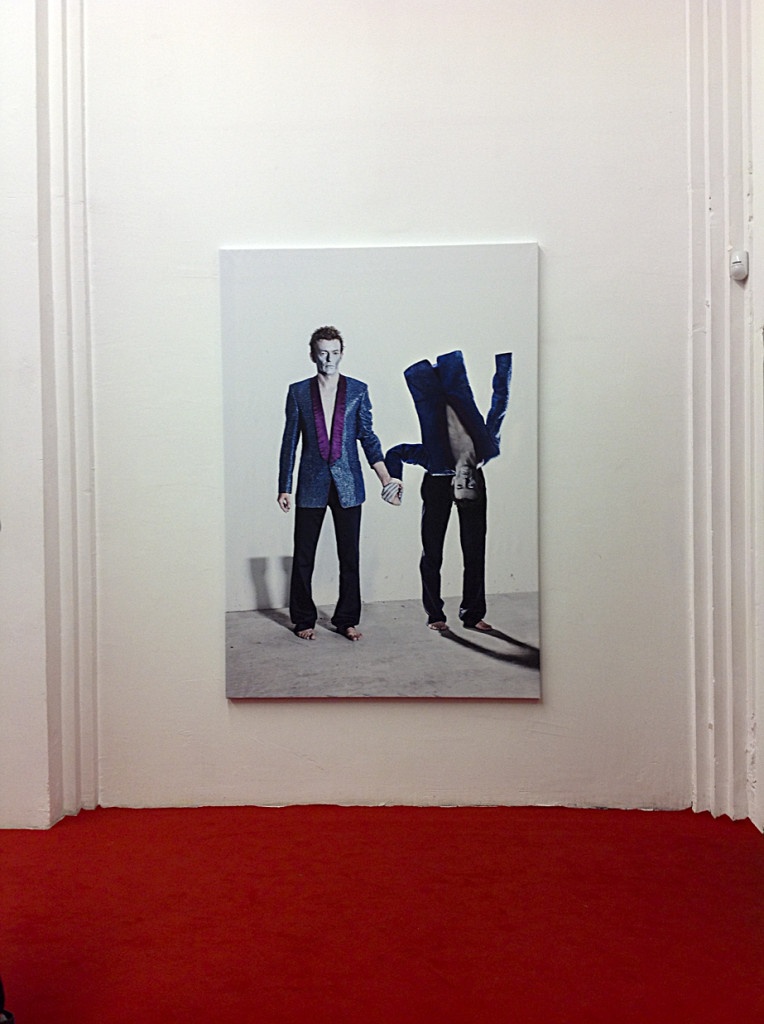
Oskar Dawicki, Raster Gallery
A certain kind of aesthetic show was offered also by Maurycy Gomulicki in the Leto gallery. His fashion design searchings hypnotise the viewer. The pop-art mural attracts and invites to joint the play with forms, shapes and colours. He plays with symbols (the Warsaw marmaid), designer items (ceramics by J. Ciaś) and fashion treated humorously. A completely different, although very aesthetic, exhibition was prepared by Bownik. The large format photographs bring to mind empty 1940s film sets and the theatrical/unnatural poses of the actors – „the stars” of the era. They are very pure, orchestrated and non-coincidental. At the same time there is a tension in them, anticipation and a strong premonition of what is beyond the frame. Both exhibitions constituted a certain kind of a time-machine, which hypnotised with the black and white play of images.
During our intensive time at WGW we managed two visits at the Stereo gallery, located in the North-Western part of the centre, which, thanks to the recent relocation of several galleries, became a sort of Warsaw’s „small Poznań”. The place and the exhibition are well worth a visit. The exhibition stood out with its strong curatorial concept. It showed not only the artists represented by the gallery, but also several invited artists. The exhibition was centred around the poetry of John Ashbery, for whom the poem is a certain abstract composition in constant movement and undergoing constant changes, escaping traditional aims and contents. It was a record of what is happening in our mind. The artists invited to the exhibition transformed objects belonging to our „home” environment and gave them on a totally different shape from their actual form and use – so close to our bodies. Their main feature – utilitarianism – vanishes. They become independent, self-shaping objects. This transformation takes place before our eyes. A photograph of a light bulb is drying on the frame, the paper sticks to the heater and merges with it, the mattress is shrinking and the puff – turned inside out – collapses, hides like a snail in its shell. Everything takes place in a quiet, sombre, almost ascetic, room.

Stereo
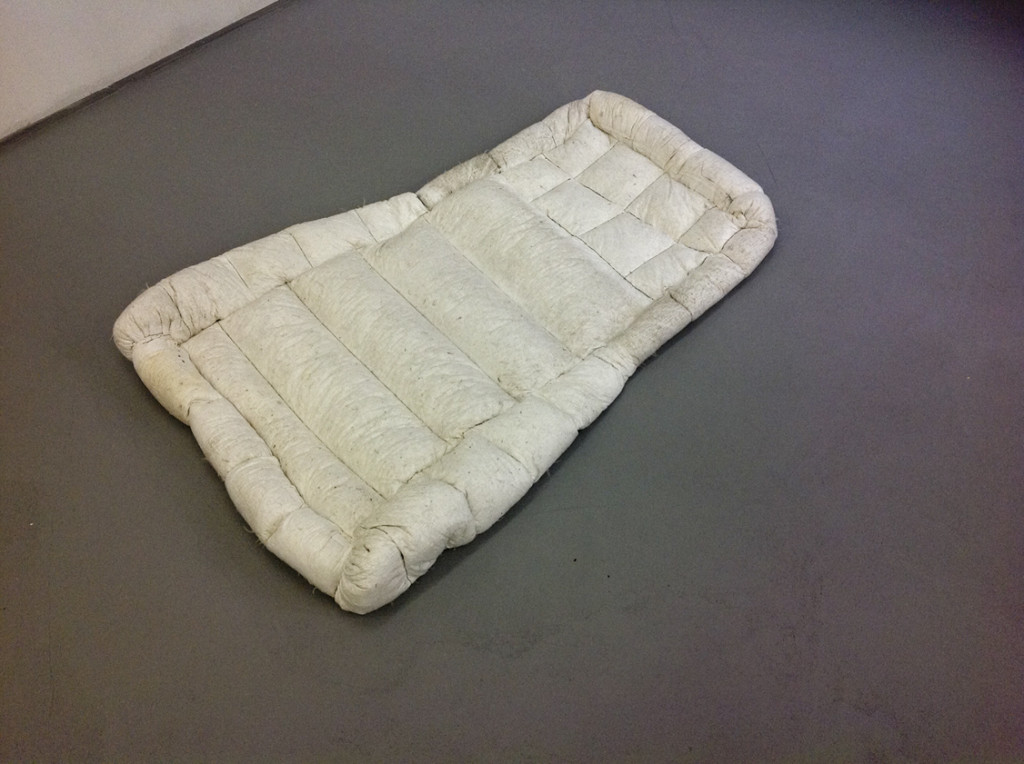
Stereo
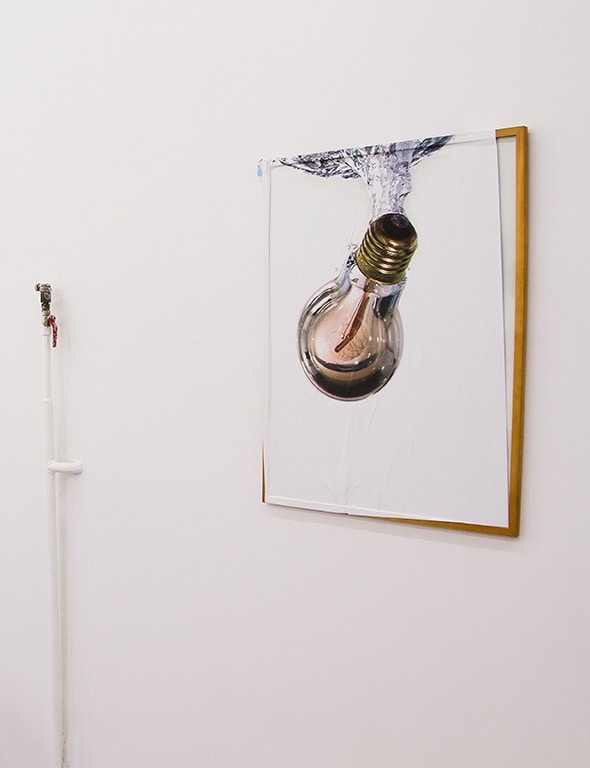
Stereo
An interesting curatorial narration could also be seen in a small, although intriguing place – Pola Magnetyczne (‘The Magnetic Fields’), where the solo exhibition of Grzegorz Kowalski was organised. The curator’s choice focused on the works created by Kowalski during his two stays in the USA and the works referring to that period. You can appreciate the evolution of the young, twenty-something artist’s disposition. After the initial moment of fascination with the Western, capitalistic culture, which could not be found in Poland, comes a moment for reflection and taking note of the black marks on America’s golden image. You can appreciate it in the fragments of notes and letters of the artist presented on the exhibition. All this is entangled with his Polish experiences and the images carried over from Poland. American clichés are not free from reflection over the situation of the country of his origin to which he came back after almost a year of absence.
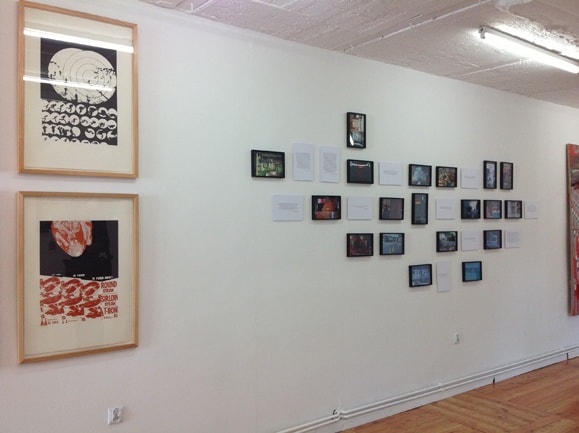
Pola Magnetyczne

Pola Magnetyczne
One last event to finish off. Among the myriad of this weekend’s offers there were also meetings and debates. We went to one of them on Saturday morning. It took place in Lookout Gallery, which was a bit far away from the centre. However, the 40 minute walk was well worth it. The talk was about collecting photographs, but more general issues were also touched upon. The creators of ArtBazaar, the interview with whom was published by us last week, took part in the discussion. Piotr Bazylko and Krzysztof Masiewicz talked about their collection and about their other projects: Art Bazaar Records, Contemporary collectors’ guidebook. They also talked about the series of collector’s folders „Tribute to….” thanks to which they wanted to encourage people who want to collect art, but hesitate to take that first step, or do not have a considerable budget. The aim of the folders was to show that you could buy works by interesting young artists (and other artists as well) for a small sum. As collecting is a passion and a way of life. If you try it once, the need to be around art will increase and become a habit, a necessary component of your life. And photography, although less popular among Polish collectors, may be a wonderful supplement to a collection, as the technique which was used to contain thoughts and feelings is not the most important (or at least not always). What is important is the way the thoughts and feelings were shown and fixed.
Translation: Ewa Tomankiewicz







